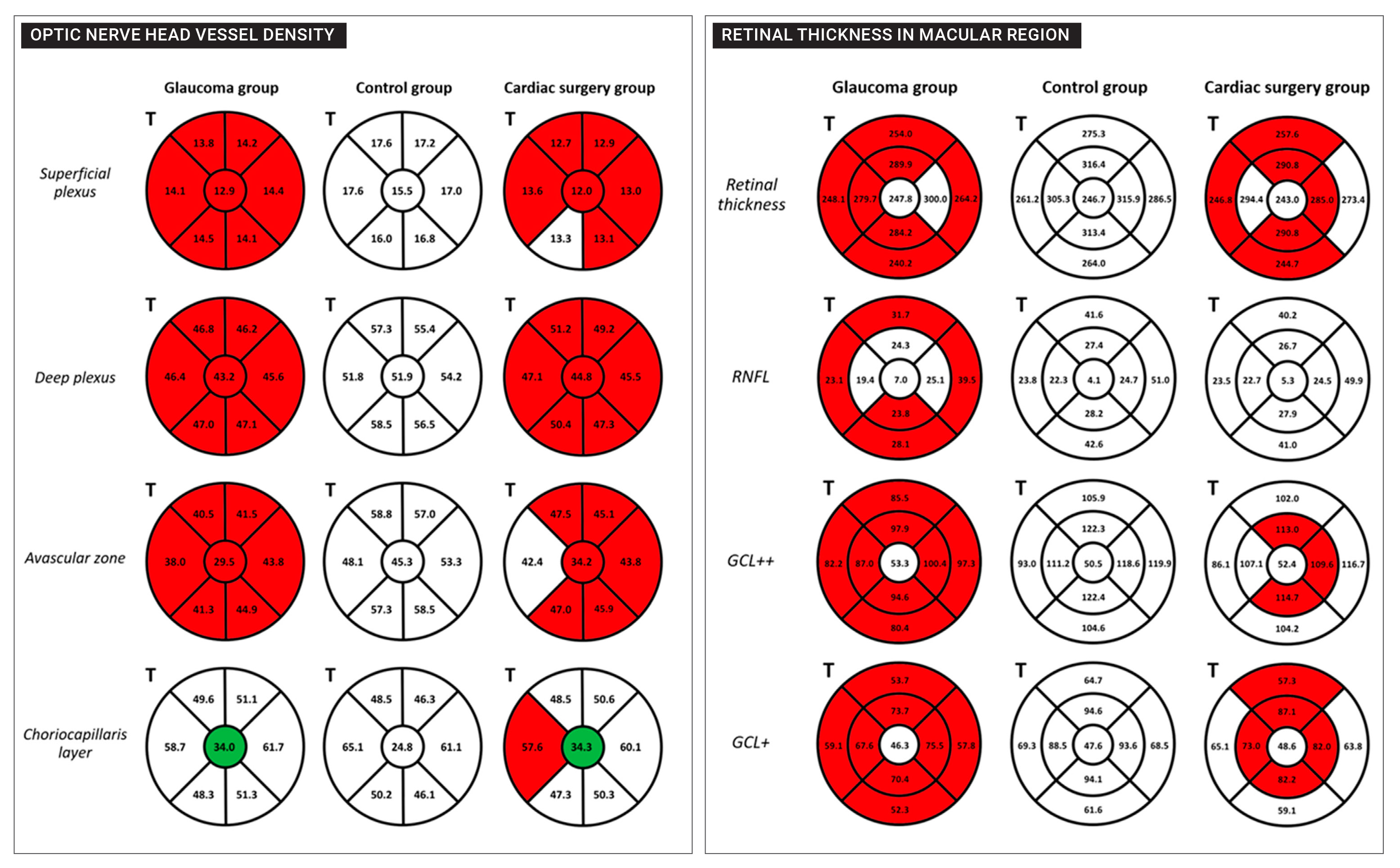 |
| Cardiac surgery patients had lower vascular and structural parameters in the optic nerve hypoplasia and macula compared to healthy controls that were similar to patients with OAG. Photo: Vicaite G, et al. Diagnostics. Feb. 29, 2024. Click image to enlarge. |
Studies have suggested impairment of ocular blood flow is a component of open-angle glaucoma (OAG) pathology, but little is known about the effect of an impaired cardiovascular supply on the structural and vascular parameters of the retina. In a new study published in the journal Diagnostics, researchers investigated the variations of these parameters in OAG patients compared to patients undergoing cardiac surgery with cardiopulmonary bypass.
A total of 82 participants (30 controls, 33 OAG patients and 19 cardiac surgery patients) who underwent ophthalmological assessment by swept-source OCT and color Doppler imaging (CDI) in one randomly selected eye were included.
Similar to several previous studies, they found a reduction in OCT angiography–derived retinal and optic nerve hypoplasia blood flow parameters in glaucoma patients compared to the controls. Cardiac surgery patients presented vessel density reduction in the optic nerve hypoplasia similar to OAG patients, in both severity and localization.
“These results suggest that patients with significant systemic cardiovascular disease may present in the peripapillary retinal microvasculature findings that are similar to those of OAG patients,” the researchers explained in their paper. “Both the OAG and cardiac surgery patients presented significantly higher vessel density in the central region of the ONH choriocapillaris layer.”
This study, as well as others, found positive correlations between ONH vessel density and RNFL thickness in OAG patients, suggesting that impaired retinal and ONH microcirculation is associated with nervous tissue thinning, the report explains. The team also found significant positive correlations between the deep plexus and avascular zone and the avascular zone and choriocapillaris layer in optic nerve hypoplasia in both the OAG and cardiac surgery groups, suggesting an interplay between the choroidal and retinal circulations, which are both important for optic nerve health and disease development, the authors noted.
A previous study found that macular thicknesses both at the global and regional levels were significantly lower in patients with pre-perimetric OAG when compared to healthy subjects. “In our study, we found a similar macular thickness decrease (excluding the foveal area) in both the OAG and cardiac surgery groups compared to healthy subjects. Importantly, the thinning of macular layers occurred with different regional distributions in these two groups.
These results, the authors suggest, indicate that structural damage at the level of the macula is associated with impaired retrobulbar circulation. These correlations were not found in the OAG patients who presented different anatomical location of the macular thinning, which indicates that the pathogenetic mechanisms behind structural damage and hemodynamic impairment in the two groups may differ.
“In conclusion, our study shows that cardiac surgery patients have reduced ONH vessel density similar to those with OAG when compared to healthy controls.” However, the “location of the structural damage at the level of optic nerve hypoplasia and macula was different.” Also, the relationship between structural and hemodynamic parameters differed in the two groups, suggesting potentially different impacts from reductions in vessel density, possibly due to faulty autoregulation of blood flow in the OAG group. “Together, this data demonstrates that significant systemic cardiovascular disease may elevate the risk for OAG, although intact vascular regulation in otherwise healthy individuals may provide a protective effect,” the authors concluded.
Vicaite G, Barisauskaite L, Bakstyte V, et al. Surgery patients have reduced vascularity and structural defects of the retina similar to persons with open-angle glaucoma. Diagnostics. February 29, 2024. [Epub ahead of print.] |


